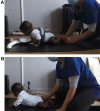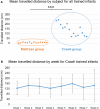Stimulating the motor development of very premature infants: effects of early crawling training on a mini-skateboard
- PMID: 37346892
- PMCID: PMC10281647
- DOI: 10.3389/fped.2023.1198016
Stimulating the motor development of very premature infants: effects of early crawling training on a mini-skateboard
Abstract
Aim: To examine the effects of an early home-based 8-week crawling intervention performed by trained therapists on the motor and general development of very premature infants during the first year of life.
Methods: At term-equivalent age, immediately following discharge from the Neonatal Intensive Care Unit (NICU), we randomly allocated 44 premature infants born before 32 weeks' gestation without major brain damage to one of three conditions in our intervention study: crawling on a mini-skateboard, the Crawliskate (Crawli), prone positioning control (Mattress), or standard care (Control). The Crawli and Mattress groups received 5 min daily at-home training administered by trained therapists for 8 consecutive weeks upon discharge from the NICU. The outcomes of greatest interest included gross motor development (Bayley-III) at 2, 6, 9, and 12 months (primary outcome) corrected age (CA), mature crawling at 9 months CA and general development at 9 and 12 months CA [Ages and Stages Questionnaires-3 (ASQ-3)]. The study was registered at www.clinicaltrials.gov; registration number: NCT05278286.
Results: A 3 (Condition) × 4 (Age) repeated measures ANOVA revealed that Crawli group infants had significantly higher Bayley-III gross motor development scores than Mattress and Control group infants. Crawli group infants also scored significantly higher on groups of Bayley-III items related to specific motor skills than infants in the other groups, including crawling at 9 months CA. We found significant differences in favor of the Crawli group in separate one-way ANOVAs at each of the ages we examined. A 3 (Condition) × 2 (Age) repeated measures ANOVA revealed that the Crawli group scored significantly higher than the Control group for the ASQ-3 total score and communication score and significantly higher for the fine motor score than the Control and Mattress groups. We found additional significant differences in favor of the Crawli group for other dimensions of the ASQ-3 in separate one-way ANOVAs at 9 and 12 months CA.
Interpretation: Early crawling training on a Crawliskate provides an effective way to promote motor and general development in very premature infants. The findings also provide clear evidence for a link between newborn crawling and more mature crawling later in development.
Keywords: cerebral palsy; crawliskate; early intervention; locomotion; neonate; newborn.
© 2023 Dumuids-Vernet, Forma, Provasi, Anderson, Hinnekens, Soyez, Strassel, Guéret, Hym, Huet, Granjon, Calamy, Dassieu, Boujenah, Dollat, Biran and Barbu-Roth.
Conflict of interest statement
MB-R, DIA and JP are co-authors on the patent for the crawling device used in the intervention. The remaining authors declare that the research was conducted in the absence of any commercial or financial relationships that could be construed as a potential conflict of interest.
Figures








References
-
- Euro-Peristat Research Network. The European Perinatal Health Report, 2015–2019. (2022).
Associated data
LinkOut - more resources
Full Text Sources
Medical

